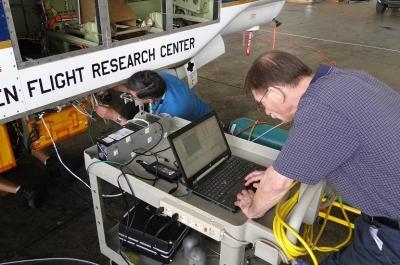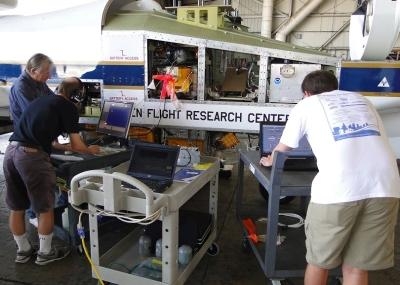Global Hawk Aircraft Now Back At Edwards Air Force Base Following Research Flights
NASA's Global Hawk research aircraft returned to its base at NASA's Armstrong Flight Research Center at Edwards Air Force Base, CA, early Friday morning March 14, marking the completion of flights in support of this year's Airborne Tropical Tropopause Experiment (ATTREX), a multi-year NASA airborne science campaign.

On Feb. 13, the autonomously operated aircraft began conducting science flights from Andersen Air Force Base on Guam in the western Pacific region on a mission to track changes in the upper atmosphere and help researchers understand how these changes affect Earth's climate.
"The western Pacific region is critical for establishing the humidity of the air entering the stratosphere," said Eric Jensen, ATTREX principal investigator at NASA’s Ames Research Center at Moffett Field, CA.
ATTREX measures the moisture levels and chemical composition of upper regions of the lowest layer of Earth's atmosphere, a region where even small changes can significantly impact climate. Scientists will use the data to better understand physical processes occurring in this part of the atmosphere and help make more accurate climate predictions.

Studies show even slight changes in the chemistry and amount of water vapor in the stratosphere, the same region that is home to the ozone layer that protects life on Earth from the damaging effects of ultraviolet radiation, can affect climate significantly by absorbing thermal radiation rising from the surface. Predictions of stratospheric humidity changes are uncertain because of gaps in the understanding of the physical processes occurring in the tropical tropopause layer.
ATTREX is studying moisture and chemical composition from altitudes of 45,000 to 60,000 feet in the tropical tropopause, which is the transition layer between the troposphere, the lowest part of the atmosphere, and the stratosphere, which extends to roughly 30 miles above Earth's surface. Scientists consider the tropical tropopause to be the gateway for water vapor, ozone and other gases that enter the stratosphere. For this mission, the Global Hawk carries instruments that will sample the tropopause near the equator over the Pacific Ocean.
ATTREX scientists installed 13 research instruments on NASA's Global Hawk 872. Some of these instruments capture air samples while others use remote sensing to analyze clouds, temperature, water vapor, gases and solar radiation.

This year, ATTREX conducted seven long-duration science flights totaling 121 hours, averaging more than 17 hours per flight. This year's flights bring the total hours flown in support of ATTREX to 297 hours since 2011.
ATTREX is one of the first research missions of NASA's new Earth Venture project. These small and targeted science investigations complement NASA's broader science research satellite missions. The Earth Venture missions are part of NASA's Earth System Science Pathfinder Program managed by Langley.
NASA monitors Earth's vital signs from land, air and space with a fleet of satellites and ambitious airborne and ground-based observation campaigns. NASA develops new ways to observe and study Earth's interconnected natural systems with long-term data records and computer analysis tools to better see how our planet is changing. The agency shares this unique knowledge with the global community and works with institutions in the United States and around the world that contribute to understanding and protecting our home planet.
(Images provided by NASA. Top: NASA Global Hawk lands at Edwards AFB. Middle: Mario Rana of Science Systems and Applications, Inc., at NASA Langley (foreground) and Jim Podolske of NASA Ames check out data recorded by the Diode Laser Hygrometer installed on NASA's Global Hawk following a 2014 ATTREX mission flight March 9 over the western Pacific Ocean. Bottom: A team of NOAA researchers checks out the UAS Chromatograph for Atmospheric Trace Species (UCATS) instrument installed in NASA's unmanned Global Hawk for the ATTREX mission.)
 Bolen Gives Congress a Rare Thumbs-Up
Bolen Gives Congress a Rare Thumbs-Up The SportPlane Resource Guide RETURNS!!!!
The SportPlane Resource Guide RETURNS!!!! Buying Sprees Continue: Textron eAviation Takes On Amazilia Aerospace
Buying Sprees Continue: Textron eAviation Takes On Amazilia Aerospace Hawker 4000 Bizjets Gain Nav System, Data Link STC
Hawker 4000 Bizjets Gain Nav System, Data Link STC Echodyne Gets BVLOS Waiver for AiRanger Aircraft
Echodyne Gets BVLOS Waiver for AiRanger Aircraft





